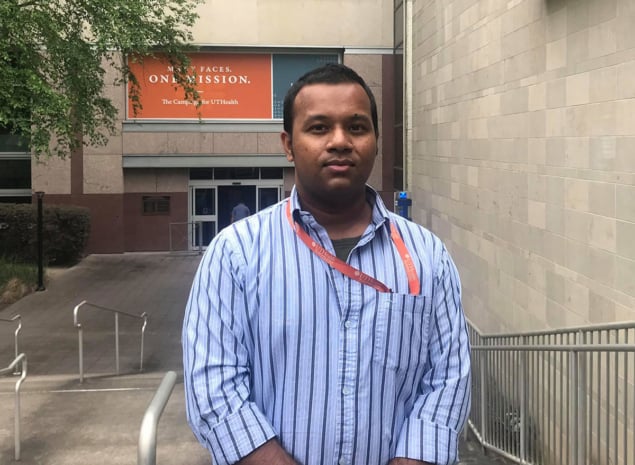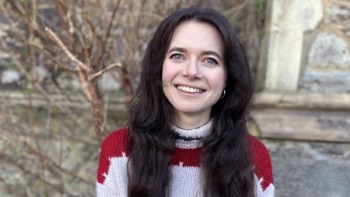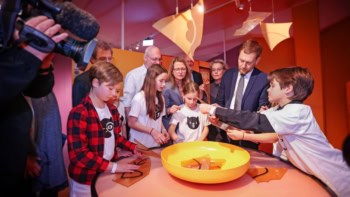Changing career path can be daunting but there are big rewards for those who are brave enough to switch. M S Zobaer describes his unexpected journey from dusty plasmas to neuroscience

What do our brains have to do with dusty plasmas in outer space? Such a question had never occurred to me when I embarked on my BSc in physics at Jahangirnagar University, in my home country of Bangladesh. To me, physics meant particles, mechanics and electricity. As a child I had been curious about how things work, breaking my electric toys to get to the motor and making my own bicycle rearlight. This fascination never went away, which is why I decided to study the subject to a higher level.
My introduction to the world of research came in the form of an MSc course at Jahangirnagar University under the supervision of the plasma physicist Abdullah Al Mamun. I worked on modelling nonlinear wave propagation under various conditions in dusty plasmas – clouds of ions, free electrons and charged dust particles in space. While learning about nonlinear wave dynamics, I developed several skills: advanced mathematical techniques, developing computer simulations with the correct parameters, and writing research papers. I enjoyed my MSc project, and felt inspired by my supervisor to continue in academic research.
After completing my MSc, I took a job as a lecturer in physics at the Bangladesh University of Textiles in Dhaka, while looking for a suitable PhD. I had my heart set on doing a theoretical project in astrophysics, plasma or nuclear physics, as I wanted to continue working in a subject closely related to my MSc thesis. PhD programmes are competitive already, but an additional complication for me was that I needed to find one that was fully funded, because my family could not support me financially. In fact, I had to decline the first two PhD offers I received because they came only with a partial scholarship.
Casting the net wide
I began to reach out to different professors, hoping that I could be put in touch with a potential PhD supervisor. Peter A Robinson, a neuroscientist at the University of Sydney, Australia, replied to me suggesting that I could consider other fields besides astrophysics. He talked about nonlinear dynamics in neural models, which are based on physical principles and mathematical derivations.
That reply spurred me to think deeply about my options, as my goal was really to become a researcher in astrophysics. I therefore decided to apply for an International Postgraduate Research Scholarship (IPRS), which is an Australian programme to support international students. As the application for the scholarship; and the application for admission to the PhD programmes were combined in one form, I ticked all the programmes offering scholarships that could cover full tuition fees and living costs in Australia.
I was fortunate enough to receive an IPRS, which was my next step to becoming a researcher, but one thing made me hesitate: the offer was to do a PhD in theoretical and computational neuroscience. Despite my conversations with Peter Robinson, I was still not completely convinced I could move into neuroscience. I had always thought of it as a field of medicine, and I was confused about how I could contribute to this area with a background in physics. My parents had similar concerns and were not sure how I could advance my career by starting a project that seemed unrelated to what I had studied so far.
A fresh start
I did some research of my own, and I was surprised to learn that in 1963 the Nobel Prize for Physiology/Medicine had been awarded to scientists for elucidating the transmission of electrical signals along neurons – essentially underpinned by physics principles. I found out that many physicists are involved in neural modelling, and I began to see how I could take the knowledge and skills I had gained while modelling plasma systems and apply them to modelling brain dynamics.
I began to see how I could take the knowledge and skills I had gained while modelling plasma systems and apply them to modelling brain dynamics
I sought advice from my MSc supervisor who told me that, across all disciplines, being a successful researcher requires dedication and time. He advised me to think hard about what I wanted to do and whether I could commit myself to this new topic, as would be necessary to give myself the best chance of success. Peter Robinson encouraged me, saying that he had also done research on plasmas before moving to neuroscience, and described similarities between the mathematics and physics underpinning both topics. This gave me more confidence to accept the PhD offer, because he knew my background and believed that I could succeed in neuroscience. The positive advice I had received from my MSc supervisor and my prospective PhD supervisor also convinced my parents that it was worth trying. I told myself and my parents that I would give myself four to five years to see if I could succeed and then, if it hadn’t worked out after this time, I would return to an office job in Bangladesh.
With this fresh outlook, I moved to Australia to begin my PhD at the University of Sydney. This was the first time I had moved abroad. I had no close relatives in Australia, and it meant starting a completely new life, in a city where people of different cultures from all over the world live. I learned to adapt to a new way of living, and how to meet people and make friends in a new environment. Australia is full of natural beauty, and I loved exploring the beaches and parks while I was there.
Connecting the dots
As I began my PhD research, I learned that the basic brain signal is made up of sine and cosine waves, and the processing is based on fundamental physical and mathematical laws, where potential, amplitude and wavelength play important roles. I studied a neural model of evoked potentials, which are electrical signals produced in specific patterns in response to certain stimuli.
In my first project, I compared evoked potentials and the corresponding brainwave characteristics during sleep and wake. I found that my physics studies had already taught me about many of the important concepts: voltage, current, peak value, frequency, superposition, overlapping, envelopes, threshold value, fluid flow and ion channels were all familiar to me.
In my second project I used the same neural model to investigate how the evoked potentials were affected when the level of neural connectivity is varied. The idea was to find out which conditions reproduced the evoked potentials that we see in abnormal electroencephalograms. While mathematical modelling of every system is unique, with its own conditions and assumptions, I found that each neural model was based on physical laws and developed through mathematical equations. Surprisingly, my work comparing brainwaves under different conditions reminded me a lot of my MSc thesis work, when I had compared the properties of nonlinear waves in plasma models with different densities of charged dust particles.
Each neural model was based on physical laws and developed through mathematical equations
In my last project, I studied the circadian rhythm and light-sensitive proteins called opsins, which are found in the photoreceptors of eyes. In addition to the computational modelling skills I had developed, my physics knowledge about light properties was invaluable during this project. I combined physical equations that I had learned during my BSc with neuroscience concepts and unified them in a model of the interactions between opsins and different wavelengths of light. One difficulty I noticed during this project was that the same physical property is defined differently in different fields of science. For example, scientists from some disciplines used the term “spectral power” to describe something that physicists would call “spectral irradiance”. In physics, these two terms mean very different things and have different units, so I needed to clearly define the concepts I was using to allow researchers from all backgrounds to easily understand my work.
Looking to the future
Shortly after attending my PhD graduation ceremony in Sydney, I received my first postdoctoral offer, funded by the Postdoctoral International Exchange Programme, to work on mathematical modelling of seizures. The programme was at Xi’an Jiaotong University in China. I moved to Xi’an, another beautiful city, and worked there for almost seven months.

Combining physics and biology: lasers and machine learning for personalized medicine
Soon after, I got an offer of another postdoctoral position, this time to work on a project funded by the National Institutes of Health in the US. To take up this position, I moved to the University of Texas Health Science Center at Houston, which is part of Texas Medical Center, the largest medical centre in the world. Since then, I have been working on a long-term research project on sleep–wake neuroscience under the supervision of Yuri A Dabaghian, another great mentor in my career. I still use ideas I first learnt in physics, such as Fourier transforms and other advanced mathematical techniques, to analyse the oscillations of different brainwave frequencies. Although I am the only physicist working on my current project, I now know several other researchers working on neuroscience projects who have come from other related disciplines such as biochemistry and pharmacy.
Looking back on my career path so far, I can say that the future is unpredictable, with an infinite number of influencing factors called “luck”. But with hard work, we can take advantage of the opportunities that come our way and may surprise ourselves by succeeding in a field we had never considered. Changing topic might be a challenge, but one thing that is common to all research fields is that they require dedication and patience. If we are willing to work hard and invest time in establishing a research career, these are the main attributes that will help us to succeed, no matter which topic we end up researching.
M S Zobaer’s tips for switching research topics and moving abroad
- Think about whether there are any similarities between your new topic and what you were studying before, and think about whether you can commit yourself to the new field
- Take time to read literature reviews of your new topic before you start your research
- Make sure you clearly define all the terms you use, so that the researchers you work with who have different backgrounds can understand your work
- Try not to compare the food, culture and life in your new home with that in your home country – just think of it as different, not better or worse
- Always keep hard copies of your passport, visa and documents in your bag in case of an emergency



